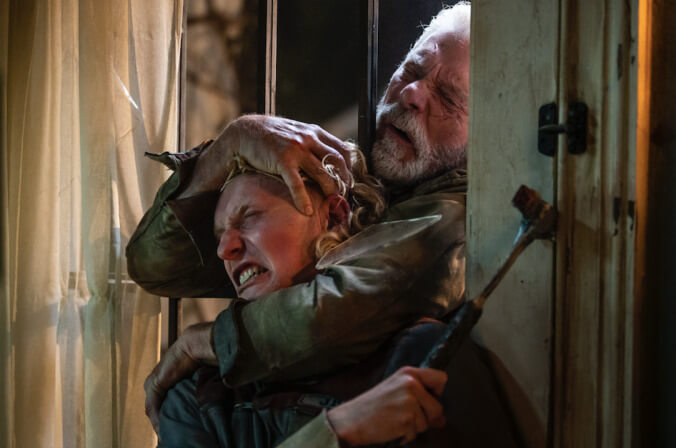Don’t Breathe 2 goes full T2, turning a memorable monster into some kind of hero
It’s less suspenseful than the well-wrought original, but true to that movie’s B-movie absurdity

One reason Terminator 2: Judgment Day remains one of the most beloved sequels of all time is its simple yet audacious twist: The fearsome killer robot played by Arnold Schwarzenegger in the horror-tinged original flips to become an unstoppable badass of human-protecting righteousness. Writer/director James Cameron accelerated the way that slasher movies would gradually defang their villains over increasingly silly entries—and exploited the audience’s deep-down desire to root for the fearsome killer on some level.
As it happens, Stephen Lang has experience in both of these areas: He’s been a bad guy for Cameron in Avatar, and he’s played a variation on a slasher in the ruthless 2016 horror-thriller Don’t Breathe, where his Norman Nordstrom only looked like a harmless old blind guy. When three young thieves broke into his house, he unleashed hell for reasons that eventually exposed both his loneliness and his mania. Now Don’t Breathe 2 is here to give him his T2 moment—a pretty tall order for anyone who remembers the ghastly secret Norman was hiding in his basement. Killer robots, after all, can be reprogrammed; human weakness is not so easily fixed.
The new movie picks up some years after the original, with Norman—who passed off the events of that entry as a simple home invasion and self-defense—still walking free on the outskirts of a dilapidated Detroit. Only now, he has an unexpected sidekick: Phoenix (Madelyn Grace), a tween girl who receives the obligatory survival training and stern warnings from her taciturn but loving father. Yes, the deranged old man from Don’t Breathe is now a #girldad, struggling with his daughter’s practically Disney-ready dreams: She wants to be where the people are, even if that just means spending more time with the kids from the local group home she sees around town. Norman would rather her stay safe and close, and for a time the sequel appears to be setting up a simple reversal of the original with laughable obviousness, complete with clunky TV news stories providing sensationalized exposition. This time, the interlopers won’t be sympathetic bumblers motivated by desperation but a bunch of flat-out creeps led by Raylan (Brendan Sexton III), trying to pull a Taken on a deadlier senior citizen than Liam Neeson.
Here is where returning screenwriters Rodo Sayagues and Fede Álvarez observe what seems to be a cardinal rule of the Don’t Breathe series: If the situation appears patently ridiculous at the outset, a more memorably ridiculous explanation will soon follow. Raylan and his crew are scumbags, yes. But the movie playfully circumvents its own signposts and, in the tradition of the original, eventually comes up with a weirder backstory than expected. At times, Don’t Breathe 2 assumes the ghoulishness of a Grimm (and grim) fairy tale, the darkness mitigating attempts to rehab Norman into a vengeful anti-hero.
Is this inventive perversity enough to sustain another 90-plus minutes on top of the well-wrought original? It may depend on an audience’s tolerance for gnarly kills—or, more often, gnarly injuries that should be more fatal than they are. Don’t Breathe 2 is almost inarguably less scary, less viscerally sweaty, than its predecessor, where every creak of the floorboards helped build the dark-room tension. Sayagues, taking over for Álvarez as director, does execute one single-shot sequence of Phoenix zipping, crawling, and rolling through her breached home, narrowly avoiding her pursuers’ eyes and grasps. But it’s executed almost like a recap—an elaborate charade for anyone expecting some choreography as a prelude to the gorehound stuff that the earlier film largely avoided. Even in that department, Sayagues feels less patient than his collaborator. Early on, one of the bad guys must “help” a colleague using creative mutilation, the kind of mishap designed to make audiences shriek with simultaneous laughter and revulsion. But the action passes too quickly to build the blackly funny inevitability of a great splat-stick gag.
As the movie continues, though, it owns its gruesome artistry, especially in the cinematography of Pedro Luque, who in some sequences approximates a kind of grindhouse Roger Deakins look—colored mists, heavy shadows, silhouettes of bodies poised for action. The increasingly ornate violence (much of it taking place in a newer if no less creaky location) fuels an effective thrill machine, and if that machine can’t match the unexpected sweetness of the T-800’s relationship with John Connor, well, maybe that’s for the best. The filmmakers make some late-going effort to actually address Norman’s rotted soul, but they can’t quite shoulder the full weight of his supposed regrets. Don’t Breathe 2 is more effective—maybe even a little mischievously insidious—in its attempted villain rehab when it sticks to smaller gestures, like Norman’s already established affinity for cuddly canine sidekicks. If Lang wants greater richness of character beyond his distinctive croak and sinewy moves, he might have to wait for Cameron to finish those Avatar sequels.